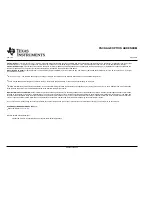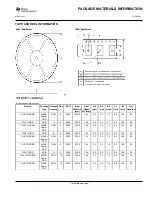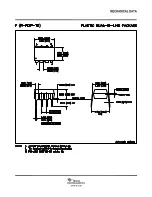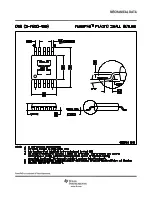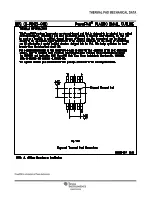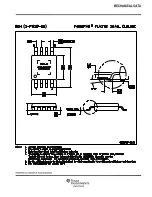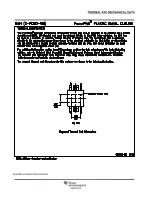
SLOS289E − DECEMBER 1999 − REVISED SEPTEMBER 2006
15
POST OFFICE BOX 655303
•
DALLAS, TEXAS 75265
APPLICATION INFORMATION
Although there are many ways to properly heatsink the PowerPAD package, the following steps illustrate the
recommended approach.
general PowerPAD design considerations (continued)
1.
The thermal pad must be connected to the most negative supply voltage on the device, GND.
2.
Prepare the PCB with a top side etch pattern as illustrated in the thermal land pattern mechanical drawings
at the end of this document. There should be etch for the leads as well as etch for the thermal pad.
3.
Place five holes in the area of the thermal pad. These holes should be 13 mils in diameter. Keep them small
so that solder wicking through the holes is not a problem during reflow.
4.
Additional vias may be placed anywhere along the thermal plane outside of the thermal pad area. This helps
dissipate the heat generated by the TLV411x IC. These additional vias may be larger than the 13-mil
diameter vias directly under the thermal pad. They can be larger because they are not in the thermal pad
area to be soldered so that wicking is not a problem.
5.
Connect all holes to the internal ground plane that is at the same voltage potential as the device GND pin.
6.
When connecting these holes to the ground plane, do not use the typical web or spoke via connection
methodology. Web connections have a high thermal resistance connection that is useful for slowing the heat
transfer during soldering operations. This makes the soldering of vias that have plane connections easier.
In this application, however, low thermal resistance is desired for the most efficient heat transfer. Therefore,
the holes under the TLV411x PowerPAD package should make their connection to the internal ground plane
with a complete connection around the entire circumference of the plated-through hole.
7.
The top-side solder mask should leave the terminals of the package and the thermal pad area with its five
holes exposed. The bottom-side solder mask should cover the five holes of the thermal pad area. This
prevents solder from being pulled away from the thermal pad area during the reflow process.
8.
Apply solder paste to the exposed thermal pad area and all of the IC terminals.
9.
With these preparatory steps in place, the TLV411x IC is simply placed in position and run through the solder
reflow operation as any standard surface-mount component. This results in a part that is properly installed.
For a given
θ
JA
, the maximum power dissipation is shown in Figure 31 and is calculated by the following formula:
P
D
+
ǒ
T
MAX
–T
A
q
JA
Ǔ
Where:
P
D
= Maximum power dissipation of TLV411x IC (watts)
T
MAX
= Absolute maximum junction temperature (150
°
C)
T
A
= Free-ambient air temperature (
°
C)
θ
JA
=
θ
JC
+
θ
CA
θ
JC
= Thermal coefficient from junction to case
θ
CA
= Thermal coefficient from case to ambient air (
°
C/W)





















